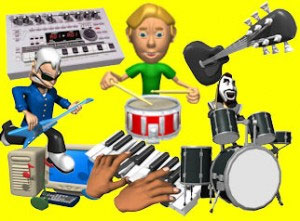I talk a lot about compression because it is such an excellent audio editing tool. But it’s very powerful and so capable of big changes in your audio, including making it (the audio) sound really bad. So it’s important to understand what compression does and at least the basics of how it works. Here are a few of my articles on compression – Improve Or Ruin Your Audio With an Effect Called Compression and Vocal Compression Using Reaper’s ReaComp Effect Plugin.
I just ran across a pretty comprehensive, if a tad technical, article that covers all of those compression basics:
http://www.tenthegg.co.uk/tips/t018/
Archives for December 2012
What is MIDI? A Big Help in Home Music Recording, That's What
 If you’re a musician doing home music recording, then you probably want to know about something called “MIDI” (pronounced middee) if you don’t already. So this article ought to be useful. But I have discovered that it is well-nigh impossible to know everything about anything. This was a great stress-relieving discovery! I always felt a little like I was somehow just toying around with something if I didn’t understand everything about it, including the origin, underlying code, every possible use, etc. But not knowing how an engine works never stopped me driving a car. Not knowing how to build a television from scratch does not make me feel unworthy to use a TV. So it is with MIDI, and most things in the music and audio recording world. You only need to know what you need to know to get the things done you need to get done. That last sentence is both profound and confusing at the same time, but it is truth! Once you accept it, your stress levels may well drop. Mine did.
If you’re a musician doing home music recording, then you probably want to know about something called “MIDI” (pronounced middee) if you don’t already. So this article ought to be useful. But I have discovered that it is well-nigh impossible to know everything about anything. This was a great stress-relieving discovery! I always felt a little like I was somehow just toying around with something if I didn’t understand everything about it, including the origin, underlying code, every possible use, etc. But not knowing how an engine works never stopped me driving a car. Not knowing how to build a television from scratch does not make me feel unworthy to use a TV. So it is with MIDI, and most things in the music and audio recording world. You only need to know what you need to know to get the things done you need to get done. That last sentence is both profound and confusing at the same time, but it is truth! Once you accept it, your stress levels may well drop. Mine did.So here is what I consider to be the most useful and basic information about midi. First, let’s try an unconventional definition. MIDI is modern “player-piano” music. Surely you’ve seen, on TV at least, those pianos from decades ago that could play by themselves, right? Well, in order for it to play a particular song, it needs someone to feed it a roll of paper with a bunch of holes in it…player-piano music. MIDI is the same thing, except for computers.
There. Done. See how easy it really is? You truly don’t need to know that MIDI is an acronym for musical instrument digital interface (or something like that….SEE? even I don’t care what it stands for!). All you really need to know is that if you have a MIDI file (*.mid), it will tell your computer to play music, usually through the MIDI instruments that exist on just about every sound card known to man in the last 10 years.
MIDI is not an audio file, like an mp3, or wav, so the file sizes are REALLY small, like the size of a text file. That’s because, like player-piano music, it’s mostly just a bunch of “on” and “off” messages. That’s one reason they are so great for the internet. Let’s say you’re on a website that has MIDI files of songs. Those files will tell YOUR computer to play the notes. It will sound different on every computer because the sound cards are different.
 You can have your MIDI file play any instrument on your sound card. For example, if you have a MIDI file of “Mary Had a Little Lamb,” it might be set to play the piano instrument on your computer. You can then switch and hear the song playing on, say, and accordion, or a fiddle. Now these sound card instruments are frequently pretty cheesy sounding. Things really start to get interesting when you procure “virtual instruments” for your computer. There are many free ones on the internet to experiment with. What’s great about those is that they sound REALLY good. Some of them are actual recordings of the real instrument! So when your MIDI file plays that instrument, it can sound astonishingly real. Just get yourself some MIDI software (a program capable of using MIDI, such as Reaper, Pro Tools and the like.
You can have your MIDI file play any instrument on your sound card. For example, if you have a MIDI file of “Mary Had a Little Lamb,” it might be set to play the piano instrument on your computer. You can then switch and hear the song playing on, say, and accordion, or a fiddle. Now these sound card instruments are frequently pretty cheesy sounding. Things really start to get interesting when you procure “virtual instruments” for your computer. There are many free ones on the internet to experiment with. What’s great about those is that they sound REALLY good. Some of them are actual recordings of the real instrument! So when your MIDI file plays that instrument, it can sound astonishingly real. Just get yourself some MIDI software (a program capable of using MIDI, such as Reaper, Pro Tools and the like.If you want to create your own MIDI files, there is lots of software out there for you to use; again, some of it free of charge. You can usually use your computer keyboards to write the notes, but most folks use a little piano-type keyboard, called midi keyboards (surprising, no?) connected via USB these days. That way, you can “record” MIDI by playing it like a piano. Then you can edit the midi file with your mouse, correcting timing and note flubs, etc. by dragging them around!
Bottom line…MIDI is awesome. Most of what you REALLY need to know is in this article, unless you are going to become a MIDI ninja. And a great place to get started becoming one of those is with our newest tutorial course – The Newbies Guide To Audio Recording Awesomeness 2 – Pro Recording With Reaper. Lesson 11 is a 3-parter showing you how to do all the stuff I talked about above using free virtual instruments.
We like to teach audio recording in plain language…like, for regular people (as opposed to engineers). If you’re not ready to buy a course yet, there are tons (over 400 at last count) of free articles right here on the site. Just click here and find out how to record good quality audio on a home studio costing $5.00 or less. Home recording is easier and less expensive than you can imagine.
See you around campus!